Risk, Crisis & Disaster Management Report for The Rocks Hotel Sydney
VerifiedAdded on 2023/06/11
|17
|3858
|281
Report
AI Summary
This report assesses risk, crisis, and disaster management at The Rocks Hotel, focusing on breaches in WHS legislation, workplace hazards, and risk treatment priorities. It examines the hotel's non-compliance with NSW legislation, particularly regarding safety and security measures and chemical labeling. Hazards identified include security vulnerabilities, management issues, and health and safety concerns for employees and guests. The report proposes management-level controls and applies a hierarchy of controls to mitigate risks, suggesting measures like CCTV installation, improved HR practices, and safer chemical usage. A cost-benefit analysis is included to evaluate the financial implications of implementing these improvements. The report concludes by highlighting the potential consequences of not improving risk management measures and emphasizes the importance of adhering to WHS Act guidelines for employee and guest safety. Desklib provides access to this and other solved assignments.
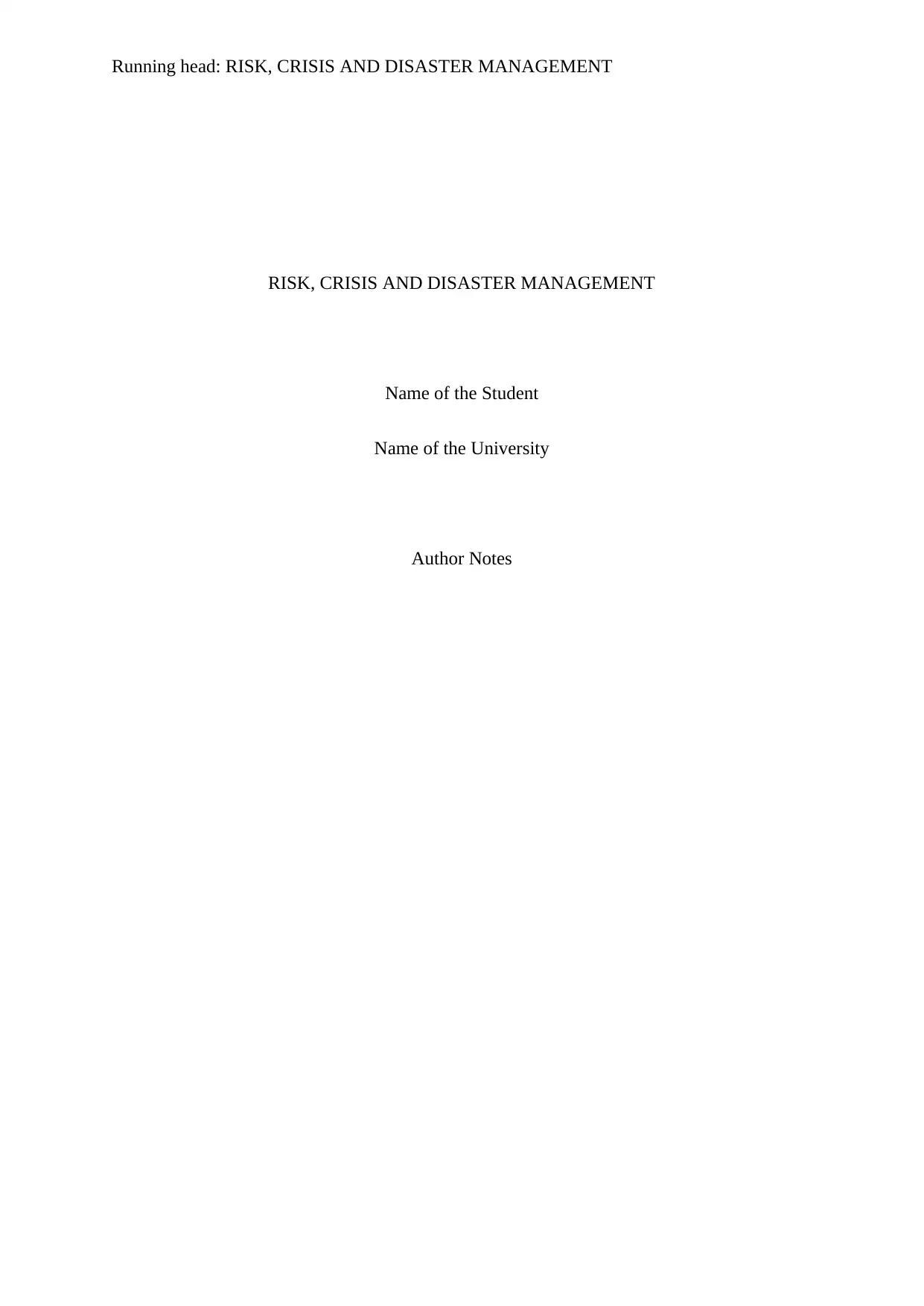
Running head: RISK, CRISIS AND DISASTER MANAGEMENT
RISK, CRISIS AND DISASTER MANAGEMENT
Name of the Student
Name of the University
Author Notes
RISK, CRISIS AND DISASTER MANAGEMENT
Name of the Student
Name of the University
Author Notes
Paraphrase This Document
Need a fresh take? Get an instant paraphrase of this document with our AI Paraphraser

1
RISK, CRISIS AND DISASTER MANAGEMENT
Executive Summary
The aim of the report is to measure the different types of risk management techniques and the
various laws associated with the same. The Australian law for the safety and the security for
the customers and clients and the law that states the mentioning of ingredients on the pack of
the products are both discussed in details. The principle aim of the report is to focus on the
case study given and find answers according to the situations provided with the practical
situations in the life. The whole case study as well as the details of the project is according to
The Rocks Hotel situated in Australia.
RISK, CRISIS AND DISASTER MANAGEMENT
Executive Summary
The aim of the report is to measure the different types of risk management techniques and the
various laws associated with the same. The Australian law for the safety and the security for
the customers and clients and the law that states the mentioning of ingredients on the pack of
the products are both discussed in details. The principle aim of the report is to focus on the
case study given and find answers according to the situations provided with the practical
situations in the life. The whole case study as well as the details of the project is according to
The Rocks Hotel situated in Australia.
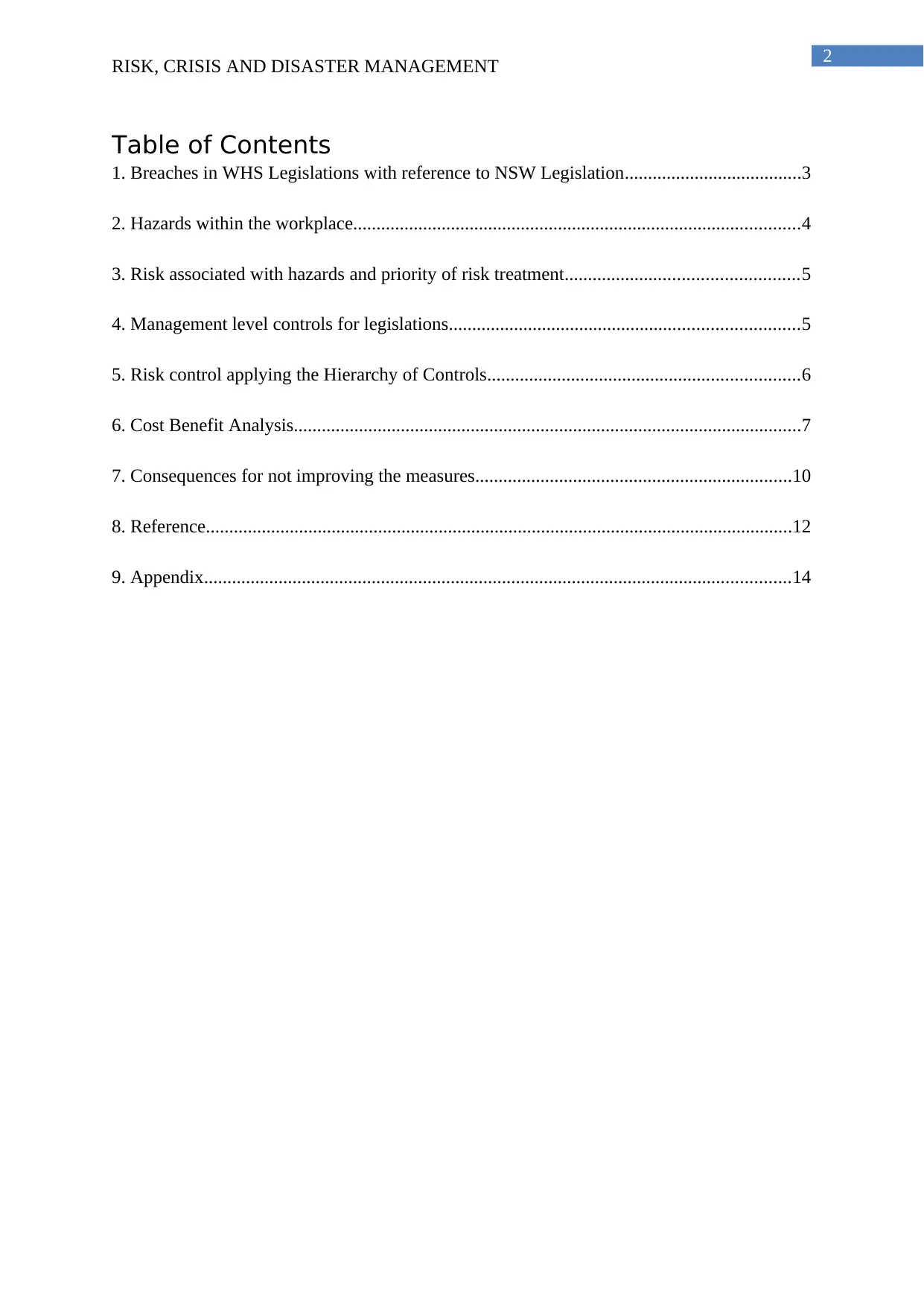
2
RISK, CRISIS AND DISASTER MANAGEMENT
Table of Contents
1. Breaches in WHS Legislations with reference to NSW Legislation......................................3
2. Hazards within the workplace................................................................................................4
3. Risk associated with hazards and priority of risk treatment..................................................5
4. Management level controls for legislations...........................................................................5
5. Risk control applying the Hierarchy of Controls...................................................................6
6. Cost Benefit Analysis.............................................................................................................7
7. Consequences for not improving the measures....................................................................10
8. Reference..............................................................................................................................12
9. Appendix..............................................................................................................................14
RISK, CRISIS AND DISASTER MANAGEMENT
Table of Contents
1. Breaches in WHS Legislations with reference to NSW Legislation......................................3
2. Hazards within the workplace................................................................................................4
3. Risk associated with hazards and priority of risk treatment..................................................5
4. Management level controls for legislations...........................................................................5
5. Risk control applying the Hierarchy of Controls...................................................................6
6. Cost Benefit Analysis.............................................................................................................7
7. Consequences for not improving the measures....................................................................10
8. Reference..............................................................................................................................12
9. Appendix..............................................................................................................................14
⊘ This is a preview!⊘
Do you want full access?
Subscribe today to unlock all pages.

Trusted by 1+ million students worldwide
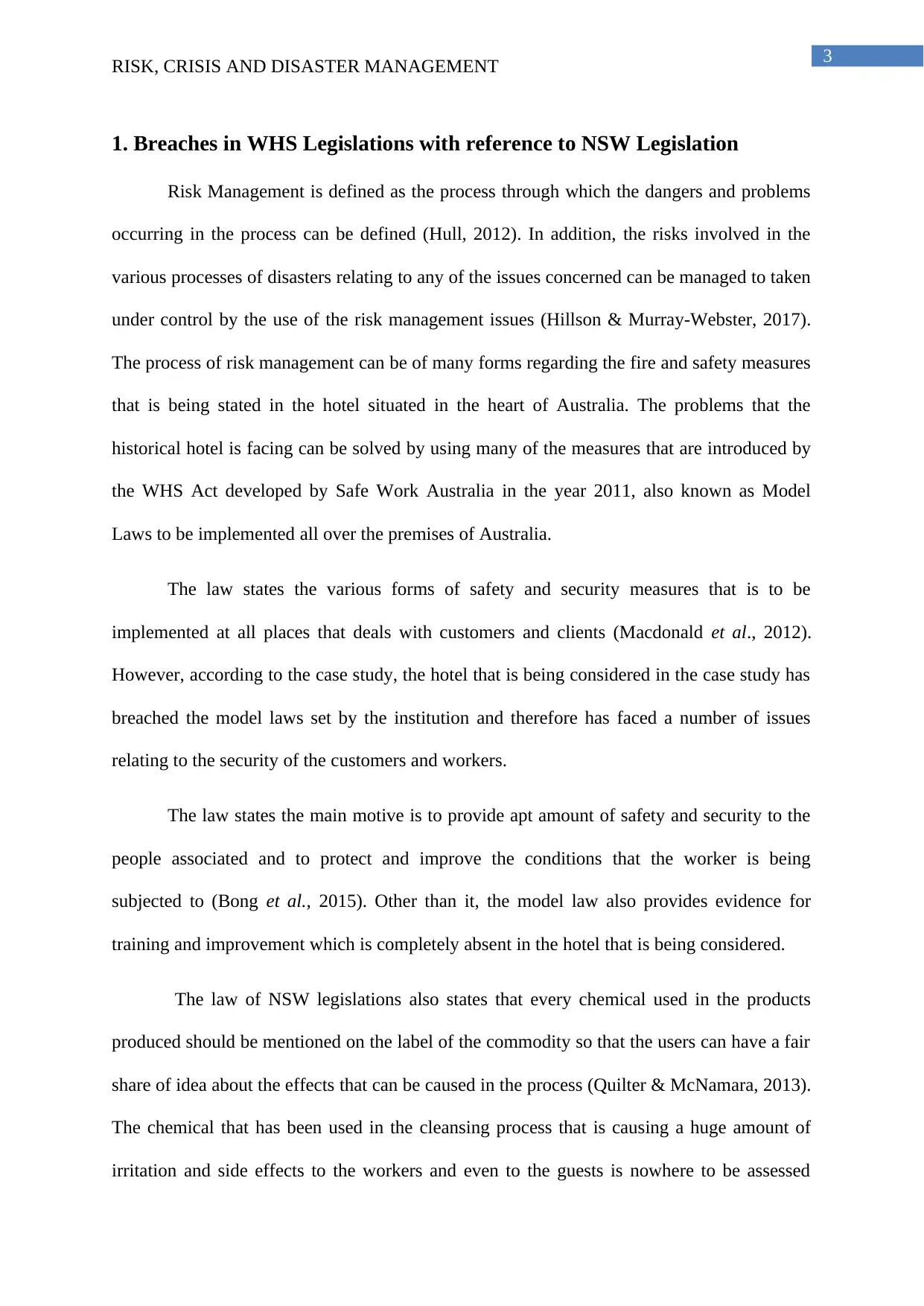
3
RISK, CRISIS AND DISASTER MANAGEMENT
1. Breaches in WHS Legislations with reference to NSW Legislation
Risk Management is defined as the process through which the dangers and problems
occurring in the process can be defined (Hull, 2012). In addition, the risks involved in the
various processes of disasters relating to any of the issues concerned can be managed to taken
under control by the use of the risk management issues (Hillson & Murray-Webster, 2017).
The process of risk management can be of many forms regarding the fire and safety measures
that is being stated in the hotel situated in the heart of Australia. The problems that the
historical hotel is facing can be solved by using many of the measures that are introduced by
the WHS Act developed by Safe Work Australia in the year 2011, also known as Model
Laws to be implemented all over the premises of Australia.
The law states the various forms of safety and security measures that is to be
implemented at all places that deals with customers and clients (Macdonald et al., 2012).
However, according to the case study, the hotel that is being considered in the case study has
breached the model laws set by the institution and therefore has faced a number of issues
relating to the security of the customers and workers.
The law states the main motive is to provide apt amount of safety and security to the
people associated and to protect and improve the conditions that the worker is being
subjected to (Bong et al., 2015). Other than it, the model law also provides evidence for
training and improvement which is completely absent in the hotel that is being considered.
The law of NSW legislations also states that every chemical used in the products
produced should be mentioned on the label of the commodity so that the users can have a fair
share of idea about the effects that can be caused in the process (Quilter & McNamara, 2013).
The chemical that has been used in the cleansing process that is causing a huge amount of
irritation and side effects to the workers and even to the guests is nowhere to be assessed
RISK, CRISIS AND DISASTER MANAGEMENT
1. Breaches in WHS Legislations with reference to NSW Legislation
Risk Management is defined as the process through which the dangers and problems
occurring in the process can be defined (Hull, 2012). In addition, the risks involved in the
various processes of disasters relating to any of the issues concerned can be managed to taken
under control by the use of the risk management issues (Hillson & Murray-Webster, 2017).
The process of risk management can be of many forms regarding the fire and safety measures
that is being stated in the hotel situated in the heart of Australia. The problems that the
historical hotel is facing can be solved by using many of the measures that are introduced by
the WHS Act developed by Safe Work Australia in the year 2011, also known as Model
Laws to be implemented all over the premises of Australia.
The law states the various forms of safety and security measures that is to be
implemented at all places that deals with customers and clients (Macdonald et al., 2012).
However, according to the case study, the hotel that is being considered in the case study has
breached the model laws set by the institution and therefore has faced a number of issues
relating to the security of the customers and workers.
The law states the main motive is to provide apt amount of safety and security to the
people associated and to protect and improve the conditions that the worker is being
subjected to (Bong et al., 2015). Other than it, the model law also provides evidence for
training and improvement which is completely absent in the hotel that is being considered.
The law of NSW legislations also states that every chemical used in the products
produced should be mentioned on the label of the commodity so that the users can have a fair
share of idea about the effects that can be caused in the process (Quilter & McNamara, 2013).
The chemical that has been used in the cleansing process that is causing a huge amount of
irritation and side effects to the workers and even to the guests is nowhere to be assessed
Paraphrase This Document
Need a fresh take? Get an instant paraphrase of this document with our AI Paraphraser
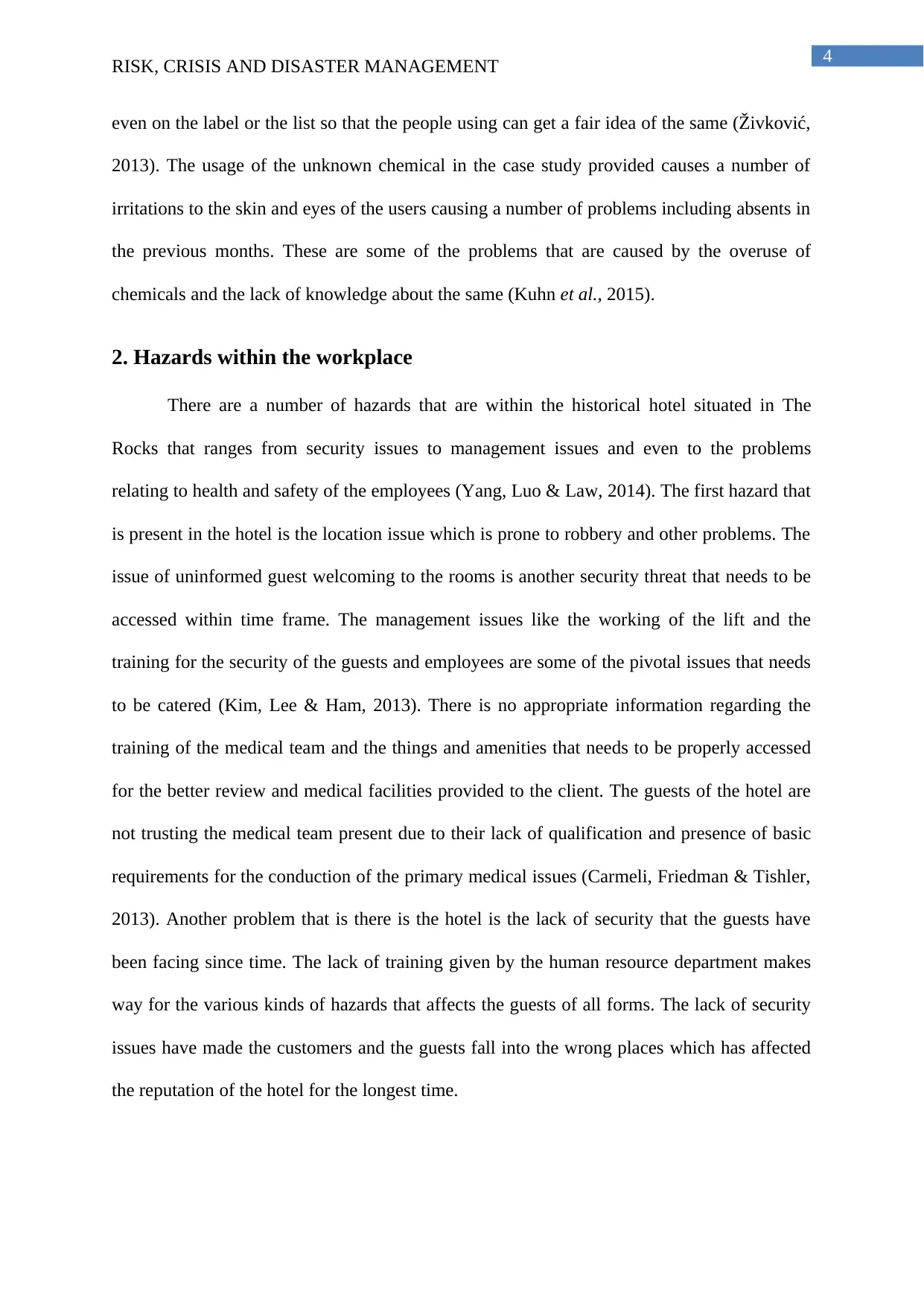
4
RISK, CRISIS AND DISASTER MANAGEMENT
even on the label or the list so that the people using can get a fair idea of the same (Živković,
2013). The usage of the unknown chemical in the case study provided causes a number of
irritations to the skin and eyes of the users causing a number of problems including absents in
the previous months. These are some of the problems that are caused by the overuse of
chemicals and the lack of knowledge about the same (Kuhn et al., 2015).
2. Hazards within the workplace
There are a number of hazards that are within the historical hotel situated in The
Rocks that ranges from security issues to management issues and even to the problems
relating to health and safety of the employees (Yang, Luo & Law, 2014). The first hazard that
is present in the hotel is the location issue which is prone to robbery and other problems. The
issue of uninformed guest welcoming to the rooms is another security threat that needs to be
accessed within time frame. The management issues like the working of the lift and the
training for the security of the guests and employees are some of the pivotal issues that needs
to be catered (Kim, Lee & Ham, 2013). There is no appropriate information regarding the
training of the medical team and the things and amenities that needs to be properly accessed
for the better review and medical facilities provided to the client. The guests of the hotel are
not trusting the medical team present due to their lack of qualification and presence of basic
requirements for the conduction of the primary medical issues (Carmeli, Friedman & Tishler,
2013). Another problem that is there is the hotel is the lack of security that the guests have
been facing since time. The lack of training given by the human resource department makes
way for the various kinds of hazards that affects the guests of all forms. The lack of security
issues have made the customers and the guests fall into the wrong places which has affected
the reputation of the hotel for the longest time.
RISK, CRISIS AND DISASTER MANAGEMENT
even on the label or the list so that the people using can get a fair idea of the same (Živković,
2013). The usage of the unknown chemical in the case study provided causes a number of
irritations to the skin and eyes of the users causing a number of problems including absents in
the previous months. These are some of the problems that are caused by the overuse of
chemicals and the lack of knowledge about the same (Kuhn et al., 2015).
2. Hazards within the workplace
There are a number of hazards that are within the historical hotel situated in The
Rocks that ranges from security issues to management issues and even to the problems
relating to health and safety of the employees (Yang, Luo & Law, 2014). The first hazard that
is present in the hotel is the location issue which is prone to robbery and other problems. The
issue of uninformed guest welcoming to the rooms is another security threat that needs to be
accessed within time frame. The management issues like the working of the lift and the
training for the security of the guests and employees are some of the pivotal issues that needs
to be catered (Kim, Lee & Ham, 2013). There is no appropriate information regarding the
training of the medical team and the things and amenities that needs to be properly accessed
for the better review and medical facilities provided to the client. The guests of the hotel are
not trusting the medical team present due to their lack of qualification and presence of basic
requirements for the conduction of the primary medical issues (Carmeli, Friedman & Tishler,
2013). Another problem that is there is the hotel is the lack of security that the guests have
been facing since time. The lack of training given by the human resource department makes
way for the various kinds of hazards that affects the guests of all forms. The lack of security
issues have made the customers and the guests fall into the wrong places which has affected
the reputation of the hotel for the longest time.
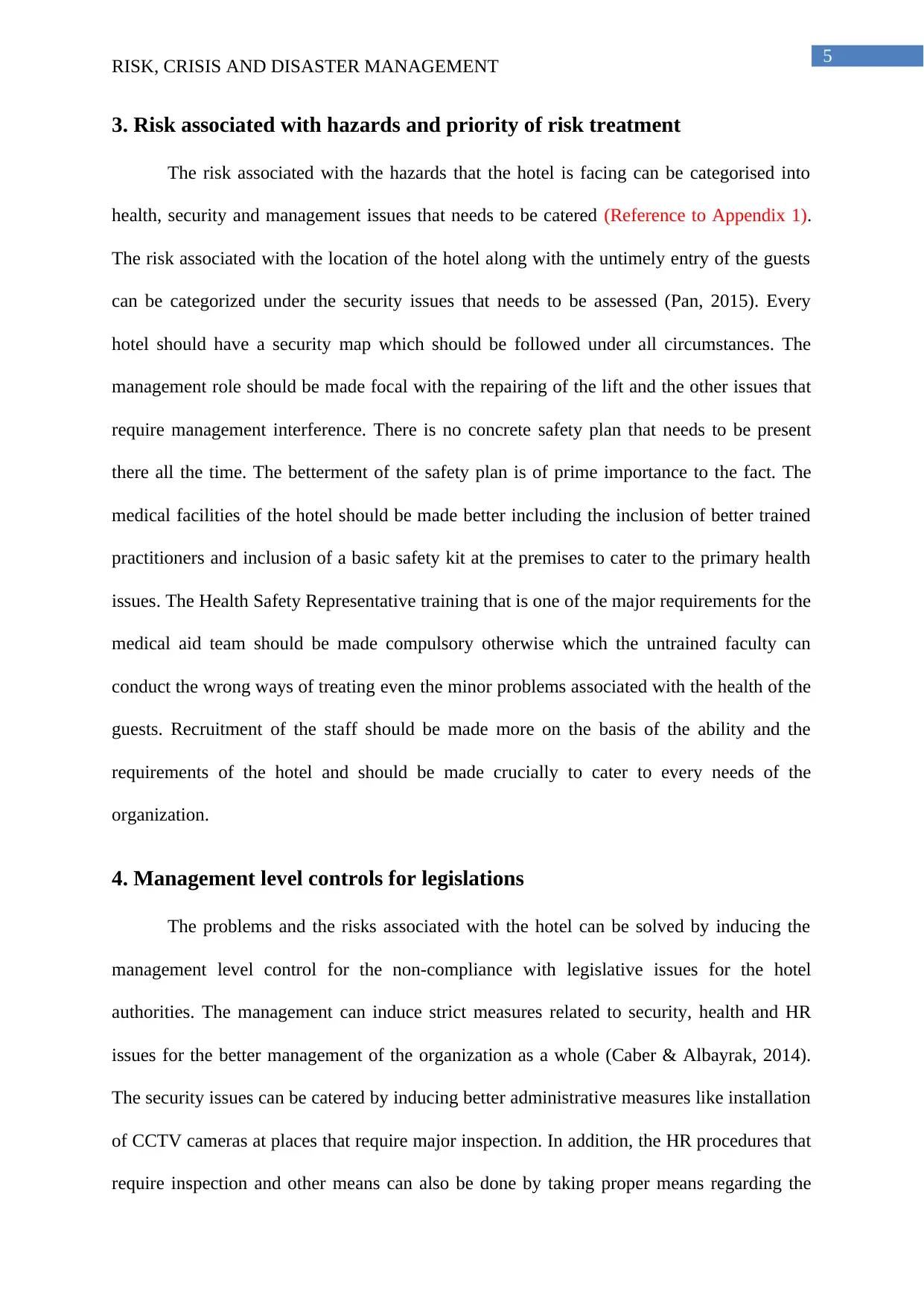
5
RISK, CRISIS AND DISASTER MANAGEMENT
3. Risk associated with hazards and priority of risk treatment
The risk associated with the hazards that the hotel is facing can be categorised into
health, security and management issues that needs to be catered (Reference to Appendix 1).
The risk associated with the location of the hotel along with the untimely entry of the guests
can be categorized under the security issues that needs to be assessed (Pan, 2015). Every
hotel should have a security map which should be followed under all circumstances. The
management role should be made focal with the repairing of the lift and the other issues that
require management interference. There is no concrete safety plan that needs to be present
there all the time. The betterment of the safety plan is of prime importance to the fact. The
medical facilities of the hotel should be made better including the inclusion of better trained
practitioners and inclusion of a basic safety kit at the premises to cater to the primary health
issues. The Health Safety Representative training that is one of the major requirements for the
medical aid team should be made compulsory otherwise which the untrained faculty can
conduct the wrong ways of treating even the minor problems associated with the health of the
guests. Recruitment of the staff should be made more on the basis of the ability and the
requirements of the hotel and should be made crucially to cater to every needs of the
organization.
4. Management level controls for legislations
The problems and the risks associated with the hotel can be solved by inducing the
management level control for the non-compliance with legislative issues for the hotel
authorities. The management can induce strict measures related to security, health and HR
issues for the better management of the organization as a whole (Caber & Albayrak, 2014).
The security issues can be catered by inducing better administrative measures like installation
of CCTV cameras at places that require major inspection. In addition, the HR procedures that
require inspection and other means can also be done by taking proper means regarding the
RISK, CRISIS AND DISASTER MANAGEMENT
3. Risk associated with hazards and priority of risk treatment
The risk associated with the hazards that the hotel is facing can be categorised into
health, security and management issues that needs to be catered (Reference to Appendix 1).
The risk associated with the location of the hotel along with the untimely entry of the guests
can be categorized under the security issues that needs to be assessed (Pan, 2015). Every
hotel should have a security map which should be followed under all circumstances. The
management role should be made focal with the repairing of the lift and the other issues that
require management interference. There is no concrete safety plan that needs to be present
there all the time. The betterment of the safety plan is of prime importance to the fact. The
medical facilities of the hotel should be made better including the inclusion of better trained
practitioners and inclusion of a basic safety kit at the premises to cater to the primary health
issues. The Health Safety Representative training that is one of the major requirements for the
medical aid team should be made compulsory otherwise which the untrained faculty can
conduct the wrong ways of treating even the minor problems associated with the health of the
guests. Recruitment of the staff should be made more on the basis of the ability and the
requirements of the hotel and should be made crucially to cater to every needs of the
organization.
4. Management level controls for legislations
The problems and the risks associated with the hotel can be solved by inducing the
management level control for the non-compliance with legislative issues for the hotel
authorities. The management can induce strict measures related to security, health and HR
issues for the better management of the organization as a whole (Caber & Albayrak, 2014).
The security issues can be catered by inducing better administrative measures like installation
of CCTV cameras at places that require major inspection. In addition, the HR procedures that
require inspection and other means can also be done by taking proper means regarding the
⊘ This is a preview!⊘
Do you want full access?
Subscribe today to unlock all pages.

Trusted by 1+ million students worldwide
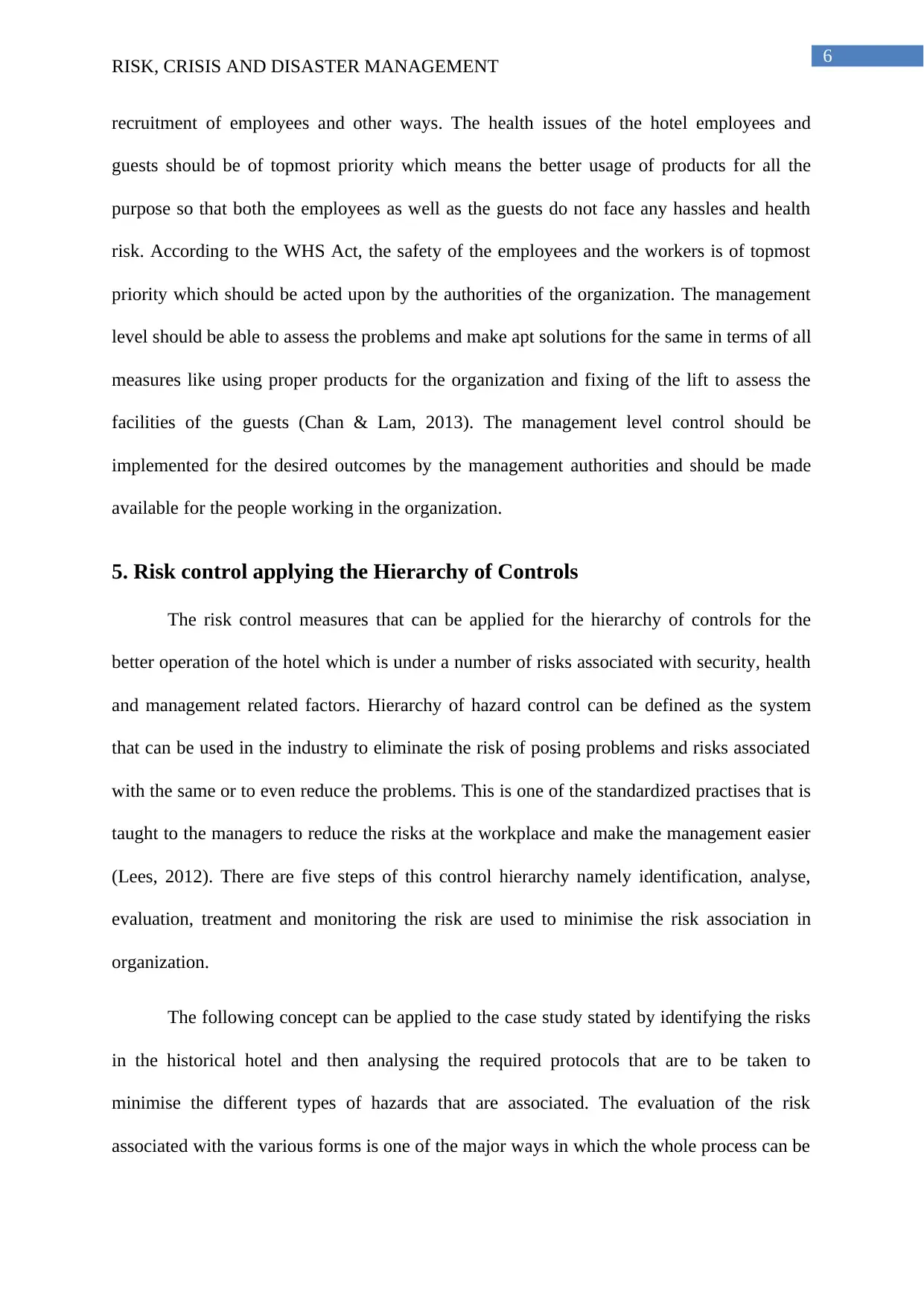
6
RISK, CRISIS AND DISASTER MANAGEMENT
recruitment of employees and other ways. The health issues of the hotel employees and
guests should be of topmost priority which means the better usage of products for all the
purpose so that both the employees as well as the guests do not face any hassles and health
risk. According to the WHS Act, the safety of the employees and the workers is of topmost
priority which should be acted upon by the authorities of the organization. The management
level should be able to assess the problems and make apt solutions for the same in terms of all
measures like using proper products for the organization and fixing of the lift to assess the
facilities of the guests (Chan & Lam, 2013). The management level control should be
implemented for the desired outcomes by the management authorities and should be made
available for the people working in the organization.
5. Risk control applying the Hierarchy of Controls
The risk control measures that can be applied for the hierarchy of controls for the
better operation of the hotel which is under a number of risks associated with security, health
and management related factors. Hierarchy of hazard control can be defined as the system
that can be used in the industry to eliminate the risk of posing problems and risks associated
with the same or to even reduce the problems. This is one of the standardized practises that is
taught to the managers to reduce the risks at the workplace and make the management easier
(Lees, 2012). There are five steps of this control hierarchy namely identification, analyse,
evaluation, treatment and monitoring the risk are used to minimise the risk association in
organization.
The following concept can be applied to the case study stated by identifying the risks
in the historical hotel and then analysing the required protocols that are to be taken to
minimise the different types of hazards that are associated. The evaluation of the risk
associated with the various forms is one of the major ways in which the whole process can be
RISK, CRISIS AND DISASTER MANAGEMENT
recruitment of employees and other ways. The health issues of the hotel employees and
guests should be of topmost priority which means the better usage of products for all the
purpose so that both the employees as well as the guests do not face any hassles and health
risk. According to the WHS Act, the safety of the employees and the workers is of topmost
priority which should be acted upon by the authorities of the organization. The management
level should be able to assess the problems and make apt solutions for the same in terms of all
measures like using proper products for the organization and fixing of the lift to assess the
facilities of the guests (Chan & Lam, 2013). The management level control should be
implemented for the desired outcomes by the management authorities and should be made
available for the people working in the organization.
5. Risk control applying the Hierarchy of Controls
The risk control measures that can be applied for the hierarchy of controls for the
better operation of the hotel which is under a number of risks associated with security, health
and management related factors. Hierarchy of hazard control can be defined as the system
that can be used in the industry to eliminate the risk of posing problems and risks associated
with the same or to even reduce the problems. This is one of the standardized practises that is
taught to the managers to reduce the risks at the workplace and make the management easier
(Lees, 2012). There are five steps of this control hierarchy namely identification, analyse,
evaluation, treatment and monitoring the risk are used to minimise the risk association in
organization.
The following concept can be applied to the case study stated by identifying the risks
in the historical hotel and then analysing the required protocols that are to be taken to
minimise the different types of hazards that are associated. The evaluation of the risk
associated with the various forms is one of the major ways in which the whole process can be
Paraphrase This Document
Need a fresh take? Get an instant paraphrase of this document with our AI Paraphraser

7
RISK, CRISIS AND DISASTER MANAGEMENT
processed and made sure that all the necessary factors regarding the working of the
organization is done on a primary level. The treatment of the various kinds of hazards
associated with the workplace especially the hotel that require enormous amount of solving
techniques is to be done accordingly. At the end, monitoring is the primary key that should be
done to make sure that such activities leading to the previously curtailed problems is not
faced at any level.
Security issues can be addressed by the installation of CCTV cameras and also the
inspection of the nearby areas with intricacy. The health issues of the workers and the clients
due to the over usage of chemical and the lack of knowledge because of the unknown
chemical composition can be handled by abandoning the use and using the ingredients that
are both pocket and skin friendly. The role of the HR should be analysed and evaluated which
also includes the training and other developmental issues to the concerned authorities. A mere
fire training summer session is not justified for the whole hotel business and there needs to be
more alertness from the authority side. At last, the management issue regarding the fixture of
the lift and other basic amenities should be done according to the plan done by the
management staff for the better facility of the organization.
6. Cost Benefit Analysis
Summary of the Results of the Analysis:
Capital Costs $0
Whole of Life Costs $436,50
0
Present Value of Benefits $376,13
8
RISK, CRISIS AND DISASTER MANAGEMENT
processed and made sure that all the necessary factors regarding the working of the
organization is done on a primary level. The treatment of the various kinds of hazards
associated with the workplace especially the hotel that require enormous amount of solving
techniques is to be done accordingly. At the end, monitoring is the primary key that should be
done to make sure that such activities leading to the previously curtailed problems is not
faced at any level.
Security issues can be addressed by the installation of CCTV cameras and also the
inspection of the nearby areas with intricacy. The health issues of the workers and the clients
due to the over usage of chemical and the lack of knowledge because of the unknown
chemical composition can be handled by abandoning the use and using the ingredients that
are both pocket and skin friendly. The role of the HR should be analysed and evaluated which
also includes the training and other developmental issues to the concerned authorities. A mere
fire training summer session is not justified for the whole hotel business and there needs to be
more alertness from the authority side. At last, the management issue regarding the fixture of
the lift and other basic amenities should be done according to the plan done by the
management staff for the better facility of the organization.
6. Cost Benefit Analysis
Summary of the Results of the Analysis:
Capital Costs $0
Whole of Life Costs $436,50
0
Present Value of Benefits $376,13
8
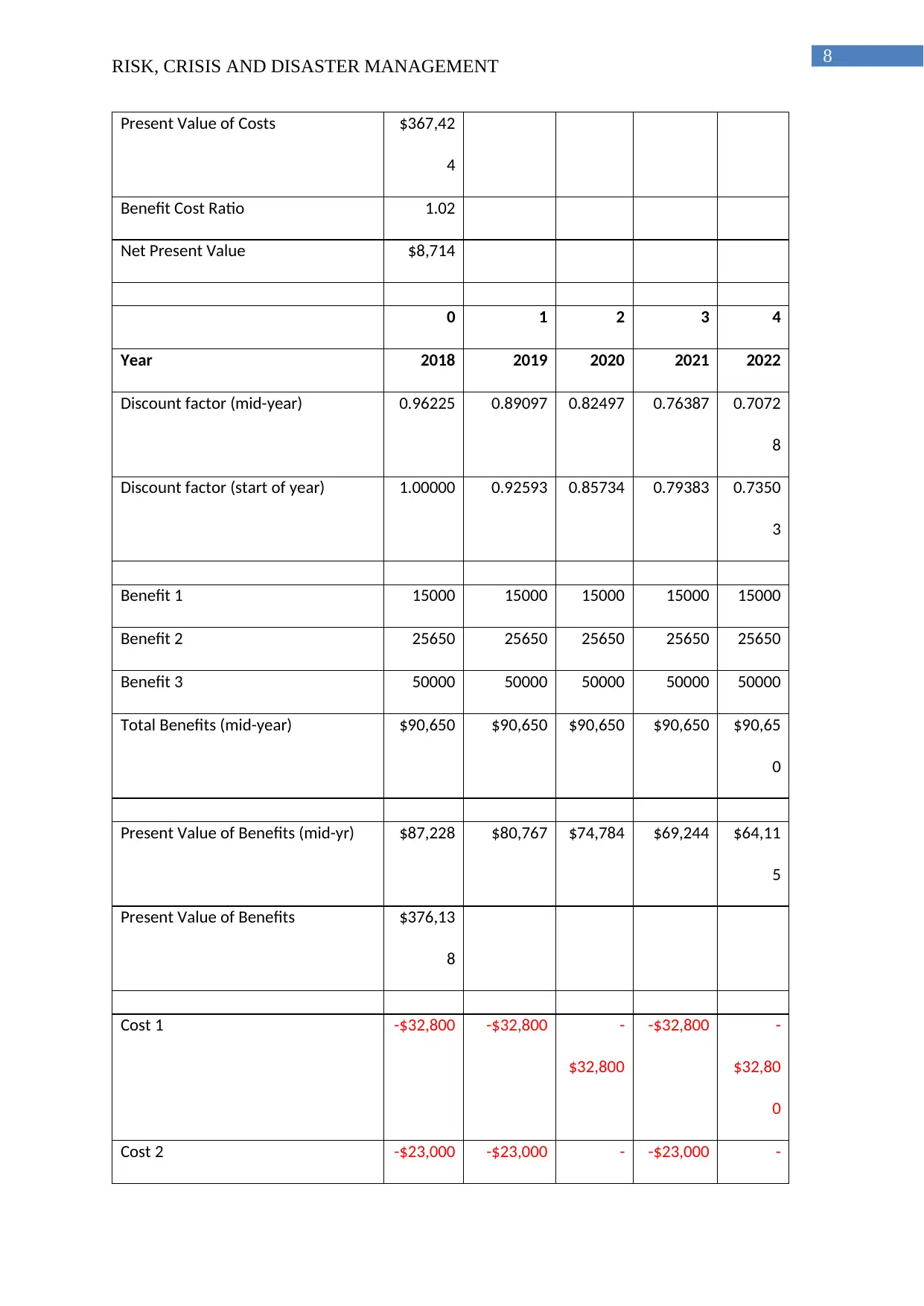
8
RISK, CRISIS AND DISASTER MANAGEMENT
Present Value of Costs $367,42
4
Benefit Cost Ratio 1.02
Net Present Value $8,714
0 1 2 3 4
Year 2018 2019 2020 2021 2022
Discount factor (mid-year) 0.96225 0.89097 0.82497 0.76387 0.7072
8
Discount factor (start of year) 1.00000 0.92593 0.85734 0.79383 0.7350
3
Benefit 1 15000 15000 15000 15000 15000
Benefit 2 25650 25650 25650 25650 25650
Benefit 3 50000 50000 50000 50000 50000
Total Benefits (mid-year) $90,650 $90,650 $90,650 $90,650 $90,65
0
Present Value of Benefits (mid-yr) $87,228 $80,767 $74,784 $69,244 $64,11
5
Present Value of Benefits $376,13
8
Cost 1 -$32,800 -$32,800 -
$32,800
-$32,800 -
$32,80
0
Cost 2 -$23,000 -$23,000 - -$23,000 -
RISK, CRISIS AND DISASTER MANAGEMENT
Present Value of Costs $367,42
4
Benefit Cost Ratio 1.02
Net Present Value $8,714
0 1 2 3 4
Year 2018 2019 2020 2021 2022
Discount factor (mid-year) 0.96225 0.89097 0.82497 0.76387 0.7072
8
Discount factor (start of year) 1.00000 0.92593 0.85734 0.79383 0.7350
3
Benefit 1 15000 15000 15000 15000 15000
Benefit 2 25650 25650 25650 25650 25650
Benefit 3 50000 50000 50000 50000 50000
Total Benefits (mid-year) $90,650 $90,650 $90,650 $90,650 $90,65
0
Present Value of Benefits (mid-yr) $87,228 $80,767 $74,784 $69,244 $64,11
5
Present Value of Benefits $376,13
8
Cost 1 -$32,800 -$32,800 -
$32,800
-$32,800 -
$32,80
0
Cost 2 -$23,000 -$23,000 - -$23,000 -
⊘ This is a preview!⊘
Do you want full access?
Subscribe today to unlock all pages.

Trusted by 1+ million students worldwide
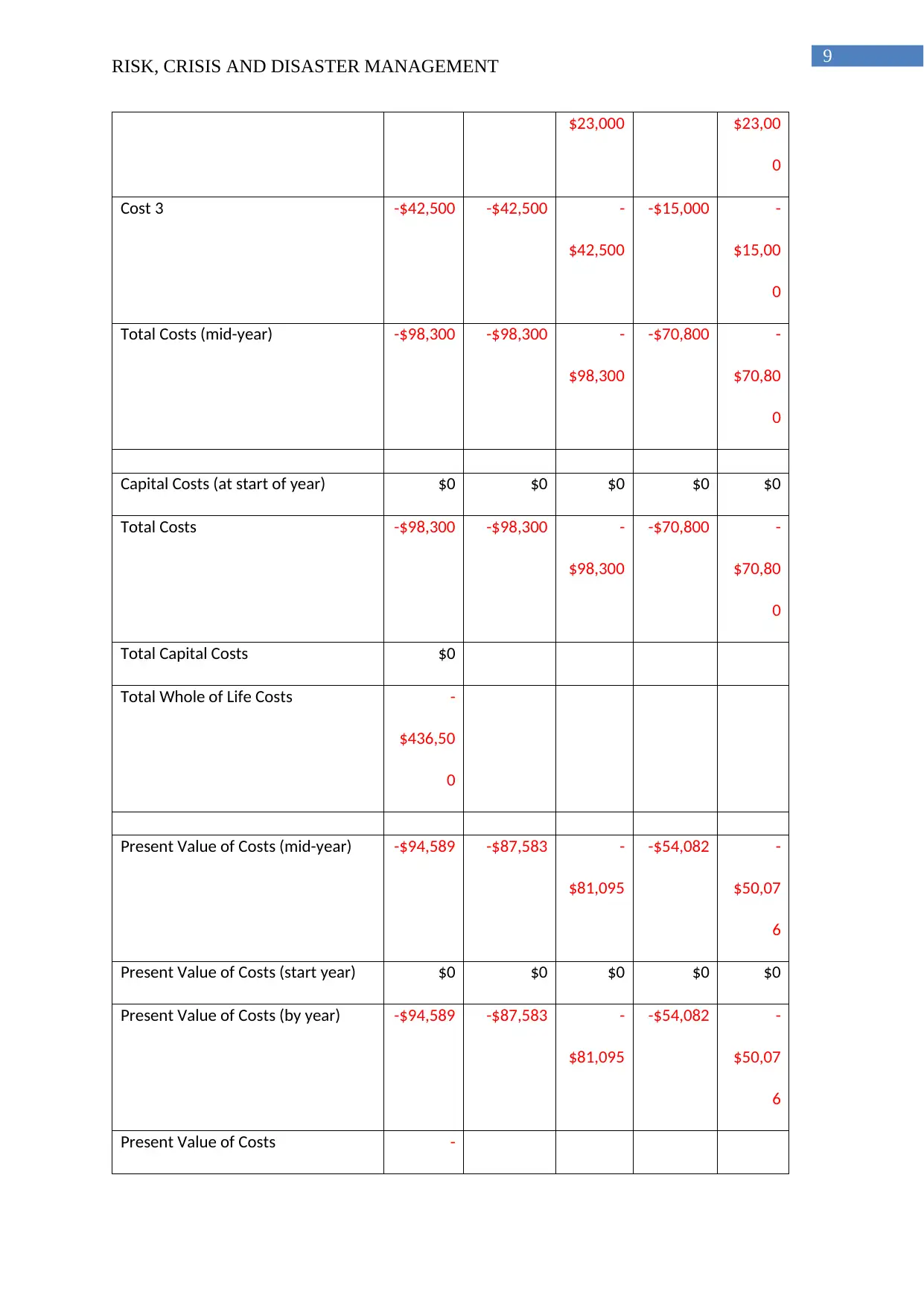
9
RISK, CRISIS AND DISASTER MANAGEMENT
$23,000 $23,00
0
Cost 3 -$42,500 -$42,500 -
$42,500
-$15,000 -
$15,00
0
Total Costs (mid-year) -$98,300 -$98,300 -
$98,300
-$70,800 -
$70,80
0
Capital Costs (at start of year) $0 $0 $0 $0 $0
Total Costs -$98,300 -$98,300 -
$98,300
-$70,800 -
$70,80
0
Total Capital Costs $0
Total Whole of Life Costs -
$436,50
0
Present Value of Costs (mid-year) -$94,589 -$87,583 -
$81,095
-$54,082 -
$50,07
6
Present Value of Costs (start year) $0 $0 $0 $0 $0
Present Value of Costs (by year) -$94,589 -$87,583 -
$81,095
-$54,082 -
$50,07
6
Present Value of Costs -
RISK, CRISIS AND DISASTER MANAGEMENT
$23,000 $23,00
0
Cost 3 -$42,500 -$42,500 -
$42,500
-$15,000 -
$15,00
0
Total Costs (mid-year) -$98,300 -$98,300 -
$98,300
-$70,800 -
$70,80
0
Capital Costs (at start of year) $0 $0 $0 $0 $0
Total Costs -$98,300 -$98,300 -
$98,300
-$70,800 -
$70,80
0
Total Capital Costs $0
Total Whole of Life Costs -
$436,50
0
Present Value of Costs (mid-year) -$94,589 -$87,583 -
$81,095
-$54,082 -
$50,07
6
Present Value of Costs (start year) $0 $0 $0 $0 $0
Present Value of Costs (by year) -$94,589 -$87,583 -
$81,095
-$54,082 -
$50,07
6
Present Value of Costs -
Paraphrase This Document
Need a fresh take? Get an instant paraphrase of this document with our AI Paraphraser

10
RISK, CRISIS AND DISASTER MANAGEMENT
$367,42
4
Net Cash Flows -$7,650 -$7,650 -$7,650 $19,850 $19,85
0
Net Present Value (by year) -$7,361 -$6,816 -$6,311 $15,163 $14,04
0
Cumulative NPV -$7,361 -$14,177 -
$20,488
-$5,325 $8,714
Chart data only:
Year 0 1 2 3 4
Present Value of Benefits ($million) $
0.087
$
0.081
$
0.075
$
0.069
$
0.064
Present Value of Costs ($million) -$
0.095
-$
0.088
-$
0.081
-$
0.054
-$
0.050
Cumulative Net Present Value
($million)
-$
0.007
-$
0.014
-$
0.020
-$
0.005
$
0.009
RISK, CRISIS AND DISASTER MANAGEMENT
$367,42
4
Net Cash Flows -$7,650 -$7,650 -$7,650 $19,850 $19,85
0
Net Present Value (by year) -$7,361 -$6,816 -$6,311 $15,163 $14,04
0
Cumulative NPV -$7,361 -$14,177 -
$20,488
-$5,325 $8,714
Chart data only:
Year 0 1 2 3 4
Present Value of Benefits ($million) $
0.087
$
0.081
$
0.075
$
0.069
$
0.064
Present Value of Costs ($million) -$
0.095
-$
0.088
-$
0.081
-$
0.054
-$
0.050
Cumulative Net Present Value
($million)
-$
0.007
-$
0.014
-$
0.020
-$
0.005
$
0.009
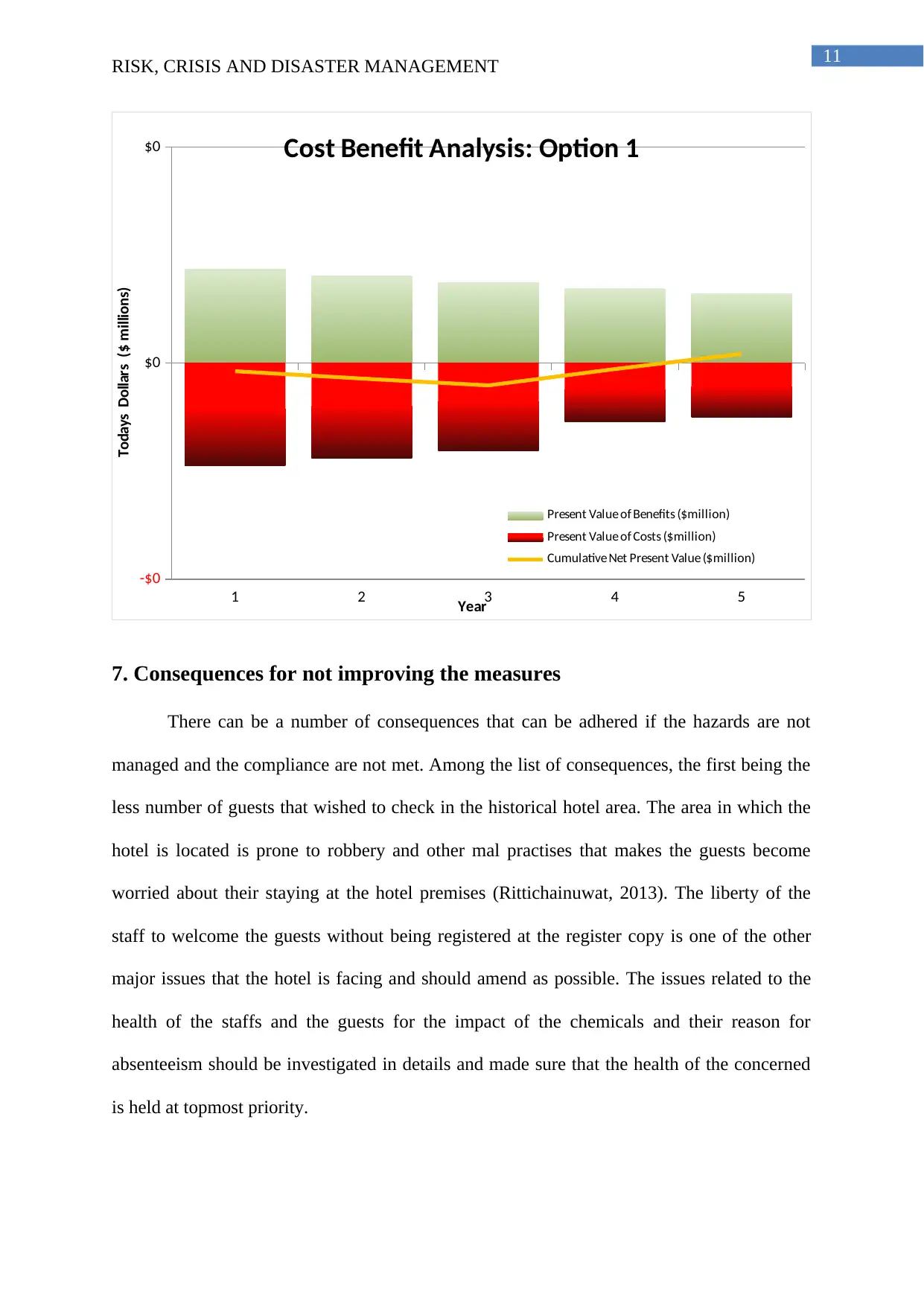
11
RISK, CRISIS AND DISASTER MANAGEMENT
1 2 3 4 5
-$0
$0
$0 Cost Benefit Analysis: Option 1
Present Value of Benefits ($million)
Present Value of Costs ($million)
Cumulative Net Present Value ($million)
Year
Todays Dollars ($ millions)
7. Consequences for not improving the measures
There can be a number of consequences that can be adhered if the hazards are not
managed and the compliance are not met. Among the list of consequences, the first being the
less number of guests that wished to check in the historical hotel area. The area in which the
hotel is located is prone to robbery and other mal practises that makes the guests become
worried about their staying at the hotel premises (Rittichainuwat, 2013). The liberty of the
staff to welcome the guests without being registered at the register copy is one of the other
major issues that the hotel is facing and should amend as possible. The issues related to the
health of the staffs and the guests for the impact of the chemicals and their reason for
absenteeism should be investigated in details and made sure that the health of the concerned
is held at topmost priority.
RISK, CRISIS AND DISASTER MANAGEMENT
1 2 3 4 5
-$0
$0
$0 Cost Benefit Analysis: Option 1
Present Value of Benefits ($million)
Present Value of Costs ($million)
Cumulative Net Present Value ($million)
Year
Todays Dollars ($ millions)
7. Consequences for not improving the measures
There can be a number of consequences that can be adhered if the hazards are not
managed and the compliance are not met. Among the list of consequences, the first being the
less number of guests that wished to check in the historical hotel area. The area in which the
hotel is located is prone to robbery and other mal practises that makes the guests become
worried about their staying at the hotel premises (Rittichainuwat, 2013). The liberty of the
staff to welcome the guests without being registered at the register copy is one of the other
major issues that the hotel is facing and should amend as possible. The issues related to the
health of the staffs and the guests for the impact of the chemicals and their reason for
absenteeism should be investigated in details and made sure that the health of the concerned
is held at topmost priority.
⊘ This is a preview!⊘
Do you want full access?
Subscribe today to unlock all pages.

Trusted by 1+ million students worldwide
1 out of 17
Related Documents
Your All-in-One AI-Powered Toolkit for Academic Success.
+13062052269
info@desklib.com
Available 24*7 on WhatsApp / Email
![[object Object]](/_next/static/media/star-bottom.7253800d.svg)
Unlock your academic potential
Copyright © 2020–2025 A2Z Services. All Rights Reserved. Developed and managed by ZUCOL.




